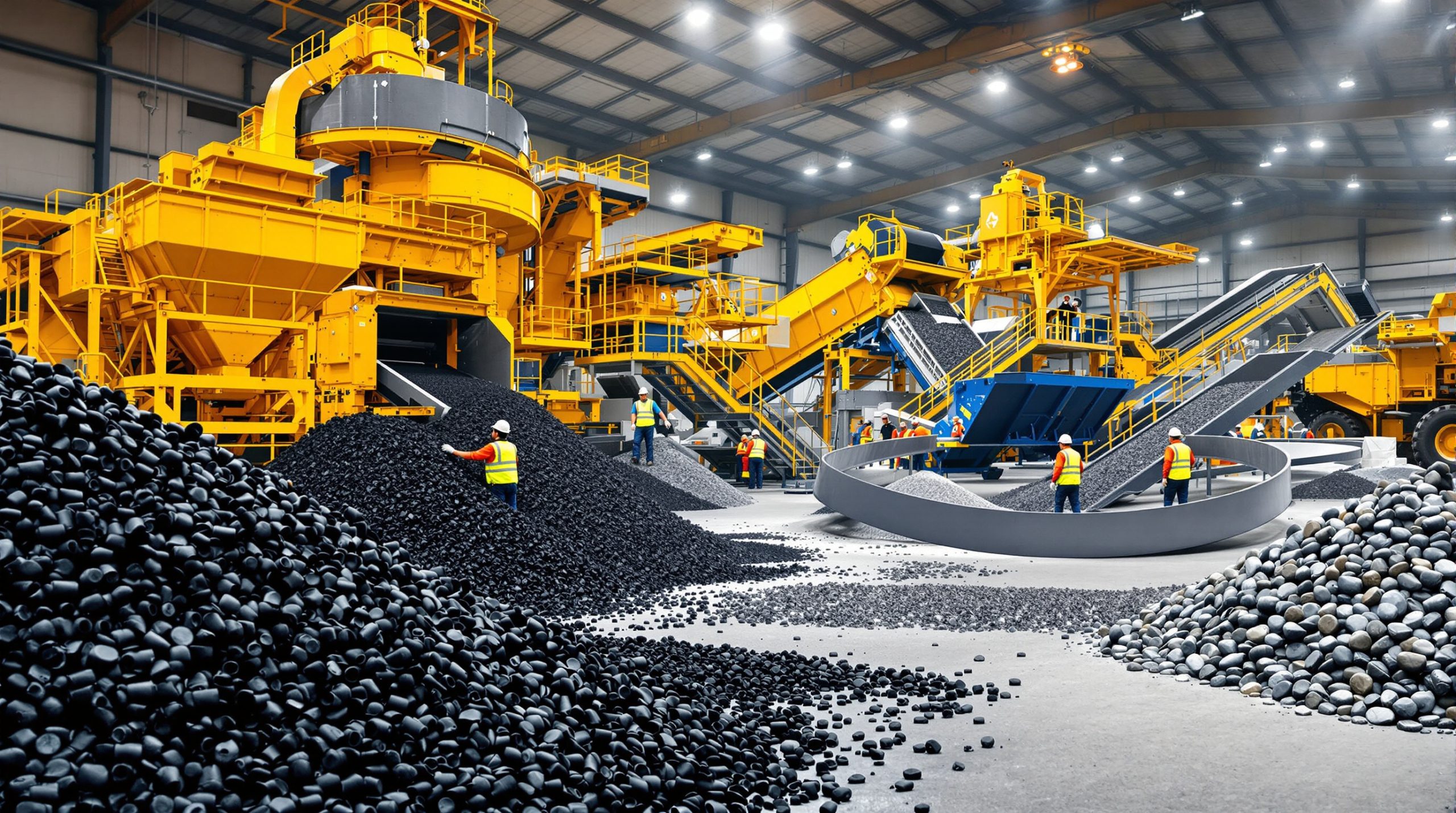What Led to the Kwinana Refinery Closure?
Aging Infrastructure and Economic Challenges
The Kwinana alumina refinery, built in 1963, faced mounting operational challenges after serving Western Australia's industrial sector for over six decades. Prior to the closure decision, the facility operated at approximately 80% of its total capacity, signaling efficiency concerns that would ultimately prove insurmountable.
As the refinery aged, maintenance costs escalated significantly, with key equipment requiring increasingly frequent and costly repairs. This maintenance burden, combined with declining bauxite ore quality from traditional supply sources, created a perfect storm of operational inefficiency.
Industry analysts noted that the facility's scale limitations compared to newer, more efficient refineries globally placed Kwinana at a significant competitive disadvantage. Modern refineries operate with substantially lower energy consumption per ton of production and utilize advanced automation systems that the Kwinana facility simply couldn't match without prohibitive capital investments.
Market Pressures and Industry Headwinds
Global aluminum market dynamics played a critical role in the Alcoa Kwinana refinery closure. Persistent aluminum price volatility severely impacted profitability margins, with the market experiencing downward pressure from significant oversupply conditions, particularly from Chinese producers operating at lower costs.
Australia's metals processing sector has struggled under the weight of exceptionally high energy costs compared to international competitors. For energy-intensive operations like alumina refining, these costs represented an increasingly unmanageable portion of overall operational expenses.
"Alcoa operated the Kwinana refinery for a number of years in a challenging environment and made the difficult decision to permanently close the facility after unsuccessfully exploring multiple options for a sustainable path to restarting," according to Matt Reed, Executive Vice President and Chief Operations Officer for Alcoa, highlighting the company's exhaustive but ultimately fruitless search for alternatives.
Labor costs presented another significant challenge, particularly in Western Australia's competitive mining environment where skilled workers command premium wages. The combination of these factors made the Kwinana refinery increasingly unviable within Alcoa's global operational portfolio.
How Will the Closure Process Unfold?
Phased Shutdown Timeline
The closure process began with a curtailment announcement in early 2024, signaling the beginning of a carefully orchestrated wind-down. By the third quarter of 2024, alumina production ceased completely, marking the end of the facility's primary function after more than six decades of operation.
Full site closure activities will continue through 2026, involving a complex series of decommissioning procedures to safely shut down industrial systems, secure hazardous materials, and prepare equipment for removal or remediation.
The extended timeline reflects the complexity of safely decommissioning such a large industrial facility. Each production system must be methodically shut down, drained of chemicals, and secured before structural dismantling can begin in earnest.
Following initial decommissioning, site preparation for potential future redevelopment will commence, with some employees remaining beyond 2026 specifically for this purpose. This extended closure timeline aims to ensure environmental compliance while maximizing the potential for future productive use of the industrial land.
Workforce Impact and Transition
The human impact of the closure cannot be overstated. From a peak workforce of approximately 800 employees during its operational height, the current workforce of about 220 employees is being progressively reduced through 2026 as closure activities continue.
A core team of approximately 50 specialists will remain for site management through 2026, focusing on environmental compliance, security, and preparation for potential redevelopment. These positions represent critical continuity roles ensuring the safe transition from active industrial site to properly remediated land.
Alcoa has established redeployment opportunities at other facilities for some personnel, particularly those with specialized skills relevant to the company's continuing operations at Pinjarra and Wagerup refineries. However, industry analysts note that these opportunities can accommodate only a fraction of the affected workforce.
Community support programs established for affected workers include retraining initiatives, career counseling, and transition assistance. The extended timeline for closure provides some buffer for workers to secure alternative employment, though the specialized nature of many refinery positions presents challenges for seamless workforce transitions.
What Are the Financial Implications of the Closure?
Cost Impact Analysis
The financial impact of the Kwinana closure is substantial, with Alcoa recording a $890 million hit in its third-quarter 2025 financial statements related to the shutdown. This figure represents one of the largest single-facility closure costs in Australia's recent industrial history.
Site rehabilitation costs have exceeded initial estimates, reflecting the complex environmental challenges associated with alumina refining facilities. The most significant component involves the management of bauxite residue (red mud) disposal areas, which require sophisticated containment and neutralization strategies.
An additional $131 million in closure-related expenses was recently identified, primarily connected to expanded environmental remediation requirements and decommissioning complexities not fully captured in initial assessments. These costs reflect the evolving understanding of site conditions as closure activities progress.
Ongoing environmental management costs are projected for several years following the physical closure, representing a long-tail financial commitment for Alcoa. These costs include groundwater monitoring, dust suppression measures, and maintenance of containment structures for residual industrial materials.
The closure also triggers potential asset write-downs affecting Alcoa's balance sheet, as specialized equipment and infrastructure designed specifically for alumina refining hold limited value outside their intended purpose. Much of the physical plant represents stranded assets with minimal salvage value compared to their original capital investment.
Operational Capacity Adjustments
The shutdown reduces Alcoa's global consolidated refining capacity to 11.7 million metric tons, representing the loss of 2.2 million metric tons of annual alumina production capacity. This capacity reduction necessitates a strategic redistribution of production across the company's global operations.
Supply chain reconfiguration for bauxite resource allocation is underway, with material previously destined for Kwinana being redirected to Alcoa's remaining Western Australian facilities at Pinjarra and Wagerup. This reallocation allows for optimization of bauxite quality across the company's continuing operations.
Industry analysts speculate about potential capacity expansion at Pinjarra and Wagerup refineries to partially offset the Kwinana closure. These facilities benefit from more modern infrastructure and greater operational efficiency, making them better positioned for potential future investment.
The capacity adjustments reflect Alcoa's broader strategic realignment toward higher-efficiency, lower-cost production assets. This shift mirrors industry modernization trends as aluminum producers globally seek to optimize their production footprints in response to competitive pressures and evolving environmental standards.
What Environmental Challenges Does the Closure Present?
Red Mud Management Crisis
Perhaps the most daunting environmental challenge stems from approximately 140 million cubic meters of caustic red mud requiring management at the site. This bauxite residue, a byproduct of the alumina refining process, contains high pH levels and potentially harmful metals requiring careful containment.
The tailings piles reach heights of up to 85 meters, creating significant stability concerns identified in environmental assessments. These structures must be carefully monitored and maintained to prevent potential breaches that could impact surrounding ecosystems and groundwater.
Red mud management requires a sophisticated approach to both physical containment and chemical stabilization. The high alkalinity (typically pH 10-13) necessitates neutralization strategies to reduce environmental risks, while physical barriers must prevent leaching into groundwater systems.
Long-term containment and remediation strategies under development include capping systems to minimize water infiltration, perimeter drainage systems to collect and treat any seepage, and comprehensive monitoring networks to detect potential containment failures. These systems represent significant engineering challenges given the scale of the disposal areas.
Groundwater protection measures requiring significant investment form another critical component of the environmental management plan. These include hydrogeological barriers, monitoring well networks, and potential pump-and-treat systems to address any contamination that may have already occurred during the facility's operational lifetime.
Site Remediation Requirements
An extensive soil and groundwater testing program is underway to characterize contamination across the industrial footprint. This assessment will guide remediation efforts, identifying hotspots requiring targeted intervention versus areas suitable for less intensive approaches.
Decontamination of processing equipment and infrastructure presents unique challenges, as decades of industrial operations have resulted in the accumulation of process residues and potentially hazardous materials within pipes, tanks, and structural components. Each system requires specific decontamination protocols based on its operational history.
The management of legacy industrial chemicals and hazardous materials stored on-site necessitates careful inventorying, handling, and disposal according to current regulatory standards. Some materials may require specialized treatment or disposal pathways not readily available within Western Australia.
Compliance with Western Australia's strict environmental rehabilitation standards guides the entire remediation process. These standards have evolved significantly since the refinery's construction in 1963, creating remediation requirements substantially more stringent than those in place during most of the facility's operational life.
A multi-decade monitoring program will likely be required post-closure to ensure containment systems function as designed and to detect any emerging environmental issues requiring intervention. This represents a long-term commitment extending well beyond the physical closure of the facility.
How Does This Closure Reflect Broader Industry Trends?
Australian Aluminum Industry Challenges
The Kwinana closure highlights similar viability concerns at other major Australian facilities. Rio Tinto has repeatedly flagged tough outlook for its Tomago aluminum smelter in New South Wales, citing costly power as the facility is the state's biggest energy user.
Glencore recently sought support for its Mount Isa copper smelter in Queensland, demonstrating that the economic pressures affecting Kwinana extend beyond aluminum to other metal processing operations across Australia. These facilities face common challenges related to energy costs, global competition, and aging infrastructure.
Energy-intensive processing has become increasingly difficult to sustain in Australia's high-cost environment. The electricity requirements for aluminum smelting and alumina refining represent a substantial competitive disadvantage compared to operations in regions with lower energy costs.
Industry experts have emphasized the critical need for government policy support for metals processing if Australia wishes to maintain domestic refining and smelting capabilities. Without such support, the trend toward exporting raw materials for processing overseas will likely accelerate.
These closures potentially reshape Australia's role in global aluminum supply chains, shifting from an integrated producer of both raw materials and refined products toward a primarily upstream supplier of bauxite for processing elsewhere. This transition has significant implications for industrial capability, employment, and economic diversification.
Global Aluminum Market Dynamics
Continued pressure from Chinese aluminum oversupply affecting global prices remains a dominant market force. China's production capacity has expanded dramatically over the past decade, creating persistent downward pressure on prices despite growing global demand.
The industry is experiencing a shifting focus toward lower-carbon, more energy-efficient production methods. This transition advantages producers with access to renewable energy sources and modern production facilities, creating additional challenges for older operations like Kwinana.
An increasing emphasis on recycled aluminum to reduce primary production needs represents another significant market shift. Secondary aluminum production requires approximately 5% of the energy needed for primary production, creating compelling economics for recycling in high-energy-cost environments like Australia.
The growing importance of supply chain security for critical industrial metals has emerged as a counterbalance to pure cost considerations. Some governments and end-users have demonstrated willingness to pay premiums for materials produced in politically stable jurisdictions with strong environmental and labor standards.
Major producers are strategically realigning their global asset portfolios to focus on lower-cost, higher-efficiency operations with improved environmental performance. This trend suggests continued pressure on older, higher-cost facilities like Kwinana regardless of short-term market conditions.
What Are the Regional Economic Impacts?
Western Australian Industrial Landscape
The closure represents a significant reduction in industrial activity within the Kwinana industrial area, which has served as a cornerstone of Western Australia's manufacturing sector for decades. The refinery's operations supported numerous auxiliary businesses and services that now face reduced demand.
The loss of direct and indirect employment opportunities in the region extends well beyond Alcoa's immediate workforce. Economic multiplier effects suggest that each refinery job supported approximately 2.5 additional positions in the broader economy through supply chains and induced spending.
Reduced local procurement spending affects supplier businesses across Western Australia. The refinery required everything from industrial chemicals to maintenance services, creating a substantial economic footprint through its operational expenditures. Many specialized suppliers now face the challenge of replacing this significant customer.
Decreased export revenue from Western Australian ports represents another economic impact, as alumina shipments from Kwinana contributed to port activity and associated logistics services. While the material volume may be partially offset by increased raw material exports, refined products typically generate greater economic value per ton.
The closure does create potential repurposing opportunities for valuable industrial land. The Kwinana site offers strategic advantages including port access, existing utility connections, and proximity to skilled labor pools, potentially attracting new industrial investment after remediation is complete.
Supply Chain Disruptions
The closure necessitates adjustments for bauxite mining operations that previously supplied Kwinana. These operations must now either redirect material to other refineries or potentially adjust production volumes, creating ripple effects throughout the mining sector.
Logistics reconfiguration for alumina exports from Western Australia is underway as shipping patterns adjust to the changed production landscape. This affects everything from rail transport to port operations as the movement of materials shifts to accommodate the altered production footprint.
Downstream aluminum producers relying on Kwinana alumina must secure alternative supplies, potentially at higher costs or with different quality specifications. This transition period creates both challenges and opportunities within the alumina market as supply chains reconfigure.
Competing refineries have the opportunity to capture market share previously served by Kwinana. This potential market redistribution may benefit both domestic and international producers, though transportation logistics will influence which facilities are best positioned to serve Kwinana's former customers.
The closure prompts a broader reassessment of Western Australia's competitive position in the global aluminum supply chain. Industry stakeholders are evaluating how the region's remaining operations can best leverage their advantages while addressing persistent challenges related to energy costs and distance to major markets.
What Does the Future Hold for the Site?
Redevelopment Possibilities
The site's industrial land repurposing potential after remediation represents a significant economic opportunity. The established industrial zoning, existing infrastructure connections, and strategic location could support a variety of future uses aligned with Western Australia's economic development priorities.
Its strategic location within the Kwinana industrial area offers particular advantages for future redevelopment. The site benefits from proximity to other industrial operations, creating potential synergies for integrated manufacturing or processing activities that could utilize shared infrastructure and services.
Energy industry analysts have identified potential for renewable energy or green hydrogen production facilities at the location. The site's existing electrical infrastructure connections and industrial footprint could support such developments, potentially contributing to Western Australia's emerging clean energy sector.
Existing infrastructure advantages including port access and utilities represent significant value for potential redevelopers. The capital costs associated with establishing these connections from scratch would be prohibitive for many projects, making previously developed industrial sites particularly attractive.
Long-term economic revitalization strategies under consideration by regional development authorities focus on attracting industries aligned with Western Australia's competitive advantages and future growth sectors. These might include advanced manufacturing, materials processing, or logistics operations leveraging the site's strategic location.
Lessons for Industrial Sustainability
The Kwinana closure highlights the importance of continuous modernization for aging industrial facilities. Incremental improvements and strategic reinvestment might have extended the refinery's viable operational life, though the fundamental challenges of scale and efficiency would have remained.
The experience underscores the critical need for energy cost competitiveness in processing industries. Energy-intensive operations like alumina refining are particularly vulnerable to disadvantages in power costs, suggesting that future industrial development in high-energy-cost regions may shift toward less energy-intensive activities.
The situation demonstrates the value of diversification in industrial economies. Regions highly dependent on single industries or facilities face greater economic disruption when market conditions change, highlighting the importance of cultivating diverse economic activities to build resilience.
Environmental legacy management has emerged as a core business consideration that must be integrated into operational planning from inception rather than addressed only at closure. The substantial costs associated with Kwinana's environmental remediation reflect the challenges of managing facilities developed under previous, less stringent environmental standards.
The closure process illustrates the delicate balance between short-term financial pressures and long-term strategic planning. While immediate market conditions may dictate closure decisions, the long-term implications for industrial capability, workforce skills, and economic development extend far beyond quarterly financial reporting cycles.
FAQ: Key Questions About the Kwinana Refinery Closure
What was the Kwinana refinery's production capacity?
The Kwinana refinery had an annual production capacity of 2.2 million metric tons of alumina, representing a significant portion of Alcoa's Australian operations. Prior to closure, the facility was operating at approximately 80% of this capacity due to various operational challenges including equipment reliability issues and process inefficiencies associated with the aging infrastructure.
How many jobs are affected by the closure?
The closure impacts approximately 220 direct employees currently working at the facility, down from a peak of around 800 during its operational height. The workforce will be progressively reduced through 2026, with approximately 50 employees remaining for long-term site management activities including environmental monitoring and security. The indirect employment impact extends to contractors, suppliers, and service providers, estimated to affect an additional 500-600 positions throughout the regional economy.
Will Alcoa maintain other operations in Western Australia?
Yes, Alcoa continues to operate its Pinjarra and Wagerup alumina refineries in Western Australia, along with associated bauxite mining operations. The company also maintains export operations at the Kwinana site even after alumina production has ceased. These continuing operations provide some redeployment opportunities for Kwinana employees with transferable skills and experience, though the total positions available are significantly fewer than those being eliminated through the closure.
What environmental challenges must be addressed during closure?
The most significant environmental challenge is the management of approximately 140 million cubic meters of caustic red mud tailings, some piled up to 85 meters high with stability concerns. This material requires long-term containment and monitoring to prevent environmental contamination. Additionally, extensive soil and groundwater remediation is needed across the industrial footprint, along with decontamination of processing equipment and infrastructure that may contain residual chemicals or contaminants from decades of industrial operation.
Could the refinery be restarted in the future?
While technically possible, industry analysts consider a restart highly unlikely given the facility's age, efficiency limitations, and the substantial investment that would be required to modernize operations. The combination of structural disadvantages including scale limitations, energy intensity, and increasingly challenging environmental compliance requirements makes redevelopment for alternative industrial uses much more economically viable than resuming alumina production. The site is more likely to be redeveloped for alternative industrial uses after remediation, potentially in sectors aligned with Western Australia's future economic development priorities.
Comparative Analysis: Australian Aluminum Industry Closures
| Facility | Closure Year | Primary Factors | Economic Impact | Environmental Legacy |
|---|---|---|---|---|
| Alcoa Kwinana | 2024-2025 | Age, costs, ore quality | $890M financial hit, 220 jobs lost | 140M m³ red mud management |
| Point Henry (Alcoa) | 2014 | Energy costs, global competition | 500 direct jobs lost | Ongoing soil remediation |
| Kurri Kurri (Hydro) | 2012 | Energy costs, carbon tax | 344 direct jobs lost | Remediation completed 2020 |
| Bell Bay Line 1 (Rio Tinto) | 2012 | Efficiency, modernization | 60 jobs affected | Minimal additional impact |
| Tomago (Rio Tinto) | At risk | Energy costs, global competition | 1,100 jobs at stake | Significant if closed |
The pattern of closures across Australia's aluminum industry reveals common threads of energy cost challenges, global competitive pressures, and the limitations of aging infrastructure. Facilities with greater scale, more modern technology, or access to lower-cost energy have demonstrated greater resilience, while older operations with structural disadvantages have progressively exited the market.
Environmental legacy management has improved significantly over time, with more recent closures benefiting from more comprehensive planning and larger remediation budgets. Earlier closures often faced more complicated and prolonged environmental challenges due to less robust closure planning during their operational lifespans.
The economic impacts extend well beyond direct employment, affecting regional economies through reduced industrial activity, decreased port utilization, and diminished local procurement. These effects are particularly pronounced in regions where aluminum production represents a significant portion of the industrial base.
Future Outlook for Australia's Aluminum Sector
Sustainability Transformation Opportunities
Renewable energy integration represents perhaps the most promising pathway to address the cost challenges facing Australia's aluminum industry. As the country develops its substantial solar and wind resources, the potential for dedicated renewable energy supply to aluminum production could significantly improve the sector's competitive position.
Industry researchers are actively exploring low-carbon alumina refining technologies that could reduce both energy requirements and carbon emissions. These technologies include alternative process chemistries and improved heat recovery systems that could substantially improve efficiency while reducing environmental impacts.
Increased focus on bauxite project benefits and residue repurposing offers potential to transform what is currently a liability into a potential resource. Research into using red mud components for construction materials, soil amendments, and metal recovery could create economic value while addressing environmental challenges.
The development of circular economy approaches for aluminum production presents another opportunity, with Australia's established collection infrastructure providing a strong foundation for expanded secondary aluminum production. The substantial energy savings associated with recycling aluminum (up to 95% compared to primary production) create compelling economics for increased circularity.
Strategic government partnerships focused on maintaining industrial capability could provide critical support during the transition period. These might include co-investment in modernization, assistance with energy costs during transitional periods, and research support for developing next-generation production technologies aligned with Australia's competitive advantages.
Market Positioning Strategies
Australian producers are increasingly emphasizing high-quality, responsibly produced alumina for premium markets where environmental and social governance credentials command value. This differentiation strategy focuses on the country's strong regulatory framework, renewable energy potential, and skilled workforce as competitive advantages.
The development of specialized alumina products for high-tech applications represents another promising direction. These higher-value products typically require greater purity and more precise specifications than commodity-grade alumina, potentially commanding price premiums that could offset Australia's higher production costs.
Industry leaders are exploring integration with Australia's critical minerals strategy, recognizing aluminum's importance in defense, aerospace, and clean energy applications. This strategic framing may attract support for maintaining domestic production capability as part of broader supply chain security initiatives.
Australia's proximity to growing Asian markets continues to offer logistical advantages compared to more distant suppliers. As transportation costs and carbon emissions associated with shipping receive increased scrutiny, this geographical advantage may grow in importance, particularly for higher-value products where transportation represents a smaller portion of total costs.
Building resilience through operational excellence and innovation remains essential regardless of specific market positioning. The facilities most likely to survive in Australia's challenging cost environment are those that achieve exceptional performance across energy efficiency, labor productivity, and environmental management while continuously adapting to changing market requirements.
The Alcoa Kwinana refinery closure represents part of broader industry consolidation trends affecting Australia's resources sector, with companies increasingly focusing on their most competitive assets. Furthermore, the growing emphasis on electrification & decarbonisation in mining and processing creates additional challenges for older facilities struggling to adapt to changing environmental expectations.
As the site transitions from active refining to remediation and potential redevelopment, lessons learned from this process will likely inform mine reclamation strategies at other aging industrial facilities across Australia, potentially establishing new benchmarks for responsible closure planning and execution in the resources sector.
Want to Stay Ahead of the Next Major Mineral Discovery?
Discovery Alert's proprietary Discovery IQ model provides real-time notifications when significant mineral discoveries are announced on the ASX, giving you a crucial market advantage before news spreads. Visit our discoveries page to see how past discoveries have generated exceptional returns and start your 30-day free trial today.




